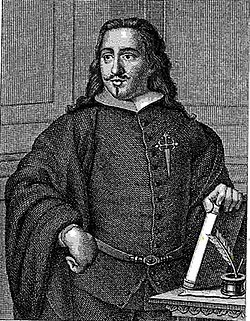Diego de Saavedra Fajardo (May 6 1584, Algezares, in Murcia—1648) was a Spanish diplomat and man of letters.

Biography
Educated for the church at Salamanca, he took orders, and in 1606 was appointed secretary to Cardinal Gaspar Borgia, the Spanish ambassador at Rome.[1] Ultimately he became Spanish plenipotentiary at Regensburg in 1636 and at Münster in 1645. He returned to Spain in 1646 and took up the post of member of the Consejo de Indias to which he had been nominated in 1636, but shortly afterwards retired to a monastery, where he died.
Although it did not get to receive greater orders, named canon him of Santiago in 1617, which was worth the importunations to him of town hall, since it never attended its position; yes ] did on the contrary to conclaves who chose to the Popes Gregorio XV (1621) and Urban VIII (1623). From this date its diplomatic activity did not know rest, because the confidence of had gained Felipe IV and it was in charge to manage a very important part of his political and diplomatic relations during thirty and five years in Italy, Germany and Switzerland, in the heat of decay the Spanish political dominion.
He was ambassador in Rome (1631) and marched to Baviera in 1633, territory this in the center and axis of the bloodiest fights of happened in War of the Thirty years and by where [ pursues from a side to another one pícaro Estebanillo González, with the position of resident ambassador in the cut of Maximiliano de Baviera, leader of the call Liga Santa, union of the favorable forces to the German Emperor Fernando II and to catholicism. In this year, to the passed away salary the antagonist of this one, the king Gustavo Adolph of Sweden in the battle of Lutzen, settled down a tense calm only interrupted by the murder of the marshal Wallenstein, head of the armies of the Emperor Fernando II, when being discovered his treason in favor of Sweden.
In 1634 takes place battle of Nordlingen between the Swedish armies and those of the German empire supported by Spanish thirds, that conclude with the victory of these. In 1636 it passes away the emperor Fernando II, and takes place Diet of Ratisbona for the election of its successor, where Saavedra goes like representative of Spain. The diplomatic activity of Saavedra intensifies in which Richelieu is the hardest part of its race with the declaration of war of the France governed by to the Spanish crown in 1635 and the successive defeats of the Spanish troops at hands of the French.
In 1640 he published the book he is best known for: his anti-Machiavellian emblem book Empresas Políticos [Political Maxims], Idea de un príncipe político cristiano, a hundred short essays on the education of a prince. These sententious works were written primarily for the son of Philip IV. It passed through a number of editions and was translated in several languages. An unfinished historical work, entitled Corona gatica, castellana, y austriaca politicamente ilustrada, appeared in 1646. Another work ascribed to Saavedra, the República literaria, was published posthumously in 1670; it is a satirical discussion on some of the leading characters in the ancient and modern world of letters.
Collected editions of his works appeared at Antwerp in 1677-1678, and again at Madrid in 1789-1790.
Notes
At the moment an Institute of Secondary Education exists that takes its name, located in [ [ Infant Juan Manuel (Murcia)|Barrio Infant Don Juan Manuel ] ] of [ [ Murcia ] ]. In Algezares, its small mother country, is a school with its name. In addition the main street to the town also this baptized with its name.
References
- ^ "Fajardo Diego de Saavedra". Catholic Encyclopedia.
{{cite web}}: Unknown parameter|retrieved=ignored (|access-date=suggested) (help)
This article incorporates text from a publication now in the public ___domain: Chisholm, Hugh, ed. (1911). Encyclopædia Britannica (11th ed.). Cambridge University Press. {{cite encyclopedia}}: Missing or empty |title= (help)